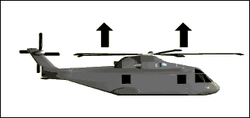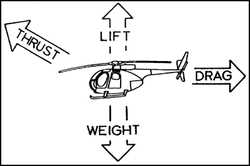Lift
The rotating blades of the helicopter cause lift which is the force that allows the helicopter to get off the ground. The shape of the blades causes the air pressure to be greater beneath the blades and propels the helicopter up. The lift that is generated by the blades can be varied based on the pitch, or angle, of the blades and the speed at which they are spinning. This action is conducted by the collective, a control stick on the pilot's left.
Movement
Helicopters can move very accurately and can fly backwards, forwards, left, right, and can hover. Other than moving forwards, these actions cannot be performed in a plane. The cyclic is a control stick in between the pilot's legs. It is responsible for controlling the movements of the helicopter. Along with the cyclic, the foot pedals control the helicopter's ability to rotate. They change the way that the tail rotor turns.
Torque
When the helicopter engine makes the rotor blades spin, it generates a force known as torque. The torque makes the helicopter uncontrollable and therefore unable to be flown. To counteract the torque, most helicopters utilize a tail rotor. This rotor is much smaller than the main rotor and is mounted perpendicularly. It rotates and causes the rest of the helicopter to counteract the torque by spinning in an opposite direction. However, some helicopters use a dual counter-rotating rotor system where there are two main rotors that spin in opposite directions. This also cancels out torque reaction. If there are no anti-torque measures, the helicopter will spin out of control and crash.
This is an illustration of what happens to a helicopter when there is no force that opposes the torque generated by the motor.
Forces Acting on Helicopters
Other than lift, there are three other main forces that act on a helicopter, thrust, drag, and weight/gravity. Thrust and drag are opposites and lift and weight/gravity are opposites. Thrust is the force that propels the object, in our case a helicopter, in any direction. Drag is the force that tries to keep the object from moving and ends up slowing it down. Weight/gravity tries to keep the object/helicopter from being elevated and causes the lift to increase in order to overcome the force of weight/gravity. Besides these main forces, there are other forces such as resonance. Resonance occurs when the rotor blade bounces off the downwash of air that is created by the rotors and ends up tearing the machine to pieces.
This video shows the result of resonance on a CH-47 Chinook helicopter.




